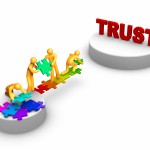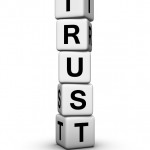One of the things more important in a team is the “TRUST”. Without “TRUST”, the team is not working well, and at the end is not a functional team. Without “TRUST”, it is like few people working together in the same room, and it is far away from a team.
Building “TRUST” in the team take time, believe or not, we are able to accelerate that process. I took the challenger of increase the trust in the team faster. To arrive to that, I take ideas of the book “The five dysfunction of a team”. The first dysfunction described in this fantastic book is “absence of trust”. What the book said and I agree is: the absence of trust is due to the believe that people is invulnerable. However, that is not real in our life, we are vulnerable and it is very important to know the vulnerability of each member of the team. It will help to create more trust and understand some kind of reactions of each member of the team.
In one of my scrum teams, I decided to apply few exercises to increase the trust inside the team. I thought, it could help a lot to build a stronger team. After re-read the already mentioned book, I took 2 exercises from there to apply to the team. Here are my experience and comments about it:
Purpose: To improve trust by giving team members an opportunity to demonstrate vulnerability in a low-risk way and to help team members understand one another at a fundamental level so that they can avoid making false attributions about behaviors and intentions.
Time Required: 15-25 Minutes
Instructions: Go around the table and have everyone answer three questions about themselves.
1. Where did you grow up?
2. How many siblings do you have and where do you fall in that order?
3. Please describe a unique or interesting challenge or experience from your childhood.
Debrief: Ask team members to share what they learned about one another that they didn’t already know. This reinforces the purpose of the exercise and allows for a natural ending to the conversation.
 Team Effectiveness Exercise (*)
Team Effectiveness Exercise (*)
Purpose of exercise: To give team members a forum for providing one another with focused, direct and actionable feedback about how their individual behavior can improve the performance of the team.
Time required: One or two hours, depending on the size of the team and the skill of the facilitator
Instructions:
1. Have all team members answer the following questions about each member of the team other than
themselves.
- What is that person’s single most important behavioral quality that contributes to the strength of the team? (That is, their strength.)
- What is that person’s single most important behavioral quality that detracts from the strength of the team? (That is, their weakness or problematic behavior.) (Note: Team members should write down their answers so that they can commit to and remember their responses, and are not tempted to change them based on what others have said.)
2. Beginning with comments about the leader of the team, have all team members read their positive
responses, one by one, until everyone has finished.
3. Ask the leader to respond to what people have said. (For example, “Any surprises? Any questions
for clarification?”)
4. Continuing to focus on the leader, have all team members read their negative responses, one by
one, until everyone has finished.
5. Continue with this sequence for every member of the team.
6. When all team members have received input from their peers, have them each summarize aloud
for the team the one or two key take-aways that they will work on individually. Have them e-mail
those take-aways to the leader.
*Both exercises originated from "Overcoming the Five Dysfunctions of a Team: a Field Guide" book.
We did both in one retrospective (coaching/training retrospective) and the learning was fantastic. I am so happy with the acceptation of these exercises by the team and how the team started to work in the sprint after this retro. Of course, they keep the good work after few sprints. Due to that, I am able to say that it was a great success.
What is your experience with “team trust”? do you try something to improve it? what did you try?
What do you think about these exercises? Did you try them?
To close this post, I want to share with you a short video about the “art of asking” and “the trust”. Enjoy it:
I really like to listen your comments and feedback. If you have any question, let me know it, I will so happy to answer.
Thank you,
Omar
If you liked this, please subscribe you to my blog updates and get updates by email (I write between 2 and 5 articles per month):
[jetpack_subscription_form title=””]

